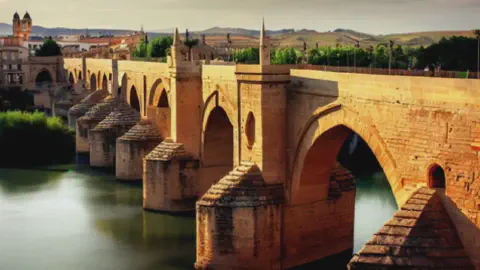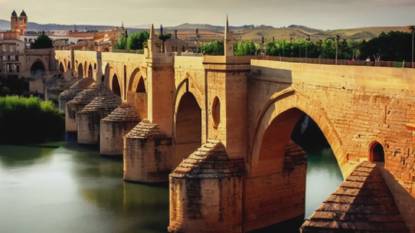
Camino Francés: Zubiri to Pamplona - Stage 3
Posted: | Updated:
Reading time: 9 minutes
Camino Francés: Zubiri to Pamplona - Stage 3
Posted: | Updated:
Reading time: 9 minutes
By: Simon Kemp, Editor
The third of the Camino Francés stages covers a distance of approximately 20 kilometers or 12.4 miles, taking pilgrims from the small town of Zubiri to the lively city of Pamplona. Along the way, walkers will encounter diverse terrain, including steep ascents and descents, river crossings, and beautiful forests.
The route features several historical and cultural landmarks, such as the iconic Puente La Reina bridge, which dates back to the 11th century and is a designated UNESCO World Heritage Site.
The statue of St. James, known as the “Miles Christi,” is a famous sight along the way, as well as the city’s medieval walls. The city of Pamplona is known for its rich history, stunning scenery, and vibrant culture, making the second stage of the Camino Francés a truly unforgettable experience for any pilgrim.
Zubiri to Pamplona Camino Route Map
Departure point: Zubiri
After travelling from Roncevalles to Zubiri , you find that Zubiri is a small town in the Navarre region of northern Spain, located about 20 kilometers from Pamplona on the Camino Francés route. The town’s name means “town of the bridge” in Basque, and it has a rich history dating back to the Roman era. Visitors can explore the medieval Puente de la Rabia bridge, the Church of San Esteban, and the colorful traditional Basque architecture. Zubiri offers many amenities for pilgrims, including accommodations, shops, and medical services. Outdoor enthusiasts can enjoy hiking and kayaking on the nearby trails and river. Don’t miss out on visiting this charming and historic destination.
Location and History
Zubiri is a town in the Navarre region of northern Spain, located approximately 20 kilometers from Pamplona. It is situated on the banks of the River Arga, which flows through the town center. The name “Zubiri” comes from the Basque language, and it means “town of the bridge.” Zubiri has a rich history dating back to the Roman era when it was an important location for controlling trade routes.
Over the centuries, the town has been occupied by various groups, including the Moors and the French during the Napoleonic Wars. One of the most significant events in the town’s history was the Battle of Zubiri, which occurred during the First Carlist War in 1834. The battle was fought between the forces of the Spanish government and the Carlists, who sought to restore the absolute monarchy in Spain.
Points of Interest
Zubiri has several points of interest for visitors. One of the most notable is the medieval bridge that spans the River Arga, known as the Puente de la Rabia. This bridge dates back to the 12th century and was an essential crossing point for pilgrims on the Camino de Santiago. The bridge is a remarkable example of medieval engineering and has survived several floods and storms over the centuries.
The town also boasts several historic buildings, including the Church of San Esteban. Built in the 13th century, it is a beautiful example of Romanesque architecture, with a simple but elegant design. The bell tower is particularly noteworthy, with a unique octagonal shape and intricate stone carvings.
The town center is characterized by narrow streets and traditional Basque architecture, with many buildings featuring colorful facades and balconies. Visitors can also explore the town’s main square, Plaza de la Constitución, which is a popular meeting place for locals and tourists alike. The square is surrounded by cafes and restaurants, making it an excellent place to relax and enjoy some of the region’s delicious cuisine.
Camino-related Services
As a stop on the Camino Francés, Zubiri offers a range of services and amenities for pilgrims. Accommodation options include hostels and hotels, with many specifically catering to pilgrims. The town has several shops selling supplies for the Camino, including walking poles, clothing, and maps. Medical facilities, pharmacies, and other essential services are also available for pilgrims.
Outdoor Activities
Zubiri is a popular destination for outdoor activities, including hiking and cycling. The town is situated on the edge of the Pyrenees and offers several hiking trails, including a section of the Camino de Santiago. The River Arga is also popular for kayaking and fishing. Visitors can rent kayaks and canoes in the town center and explore the river and its surrounding landscapes.
In summary, Zubiri is a charming town with a rich history and a range of attractions and services for visitors. Whether you’re a pilgrim on the Camino de Santiago or a tourist exploring the region, Zubiri is a destination that is worth visiting. The town’s medieval bridge, historic buildings, and traditional Basque architecture offer a glimpse into the region’s past, while its outdoor activities and modern amenities make it a practical and enjoyable place
Zubiri to Pamplona: Route Description
The Camino Frances section from Zubiri to Pamplona is approximately 20 kilometers and is characterized by diverse terrain, including steep ascents and descents, river crossings, and beautiful forests. This stage is rated as moderate, with some challenging sections due to the steep climbs. The following stage is from Pamplona to Puente la Reina .
The route begins in the town of Zubiri and quickly crosses the River Arga on the historic Puente de la Rabia, a remarkable example of medieval engineering. Pilgrims then ascend a steep hill, passing through lush forests and meadows, before arriving at the charming village of Larrasoaña.
Puente La Reina bridge,The route then follows a quiet country road for several kilometers, passing through small hamlets and fields of wheat and corn. One of the highlights of this section is the iconic Puente La Reina bridge, which dates back to the 11th century and is a designated UNESCO World Heritage Site. The bridge spans the River Arga and was an important crossing point for pilgrims on the Camino de Santiago.
After crossing the bridge, pilgrims will enter the town of Trinidad de Arre and pass through a beautiful oak forest before arriving at the foot of the Alto del Perdón. This steep climb is well worth the effort for the stunning views at the top, which include a wind farm and a monument to pilgrims. From the Alto del Perdón, the trail descends into the town of Uterga and passes through a series of small villages before reaching the town of Obanos.
The trail continues through a series of small towns and villages, including Cirauqui, whose Romanesque church dates back to the 12th century. The town of Lorca is also worth a visit, with its well-preserved medieval streets and the Church of San Salvador, which features a beautiful Romanesque doorway.
Finally, after crossing a small hill, pilgrims will reach the city of Pamplona, the capital of the Navarra region. The city is best known for the San Fermín festival, which includes the famous running of the bulls. However, it also has a rich history and a range of cultural attractions, including the Gothic-style Cathedral of Santa María la Real and the Citadel, a 16th-century fortress that is now a public park.
Overall, the route from Zubiri to Pamplona is a challenging but rewarding experience for any pilgrim. With its diverse terrain, stunning scenery, and rich history, this stage of the Camino Francés is truly an unforgettable journey.
Destination: Pamplona
Pamplona is a city in northern Spain that is located on the Camino Francés pilgrimage route to Santiago de Compostela. The city is best known for its annual Running of the Bulls festival, but it also has a rich history and many cultural attractions for visitors.
Pamplona is a city with a rich history and many cultural attractions for visitors. While it is best known for its Running of the Bulls festival, the city offers much more to see and do. Its location on the Camino Francés pilgrimage route makes it a convenient and practical destination for pilgrims, and its range of services and amenities make it a comfortable place to stay. Whether you are visiting during the San Fermín festival or at another time of year, Pamplona is a city that is well worth exploring.
Location and History
Pamplona is the capital city of the Navarre region in northern Spain, and it sits on the banks of the Arga River. The city has a long and fascinating history, dating back to Roman times when it was known as Pompaelo. During the Middle Ages, Pamplona was an important stop on the Camino de Santiago pilgrimage route, and it played a significant role in the Spanish Civil War in the 20th century. Today, Pamplona is a vibrant and cosmopolitan city that attracts visitors from around the world.
Points of Interest
Pamplona offers a range of attractions for visitors. The most famous is the Running of the Bulls festival, which takes place every year during the city’s San Fermín festival in July. The festival attracts thousands of visitors from around the world, who come to watch the spectacle of people running ahead of the charging bulls through the city’s narrow streets. Other attractions in the city include the historic center, which is home to many Gothic and Renaissance-style buildings and monuments. One of the most notable is the Pamplona Cathedral, a beautiful Gothic cathedral that was built in the 14th and 15th centuries. Other landmarks include the Castle of the Old Quarter, a medieval fortress that now houses the city’s Museum of Navarre, and the Plaza del Castillo, a beautiful public square that is lined with restaurants and cafes.
Camino-related Services
As a stop on the Camino Francés pilgrimage route, Pamplona offers a range of services and amenities for pilgrims. Accommodation options include hostels and hotels, and visitors can also find restaurants and cafes serving traditional Spanish cuisine. Medical facilities, pharmacies, and other essential services are also available for pilgrims, making it a practical and convenient destination.
Public transportation options
There are a few options for public transportation from Zubiri to Pamplona in Spain:
- Taxi: You can catch a taxi from Zubiri to Pamplona with Taxi Asier or Tele Taxi San Fermín. This is the quickest way to get there. A taxi ride from Zubiri to Pamplona costs between €25 – €31.
- Bus: There is no direct bus connection from Zubiri to Pamplona. However, you can take a taxi to Huarte Ctra. Huarte-Pamplona and then take the bus to Avda. Conde Oliveto nº 2. The combined cost of a taxi to the bus station and a bus ticket to Pamplona is around €22 – €25.
- Car: If you have access to a car, you can drive from Zubiri to Pamplona. If you’re driving, the cost of fuel would be around €3 – €6.
Please note that travel times and costs can vary, so it’s a good idea to check for the most current information before your trip.

